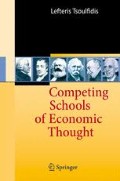Abstract
The stagflation that afflicted the US and the other economies after the late 1960s shook the economists’ faith in Keynesian economics or Monetarism. The Keynesians could explain the rising price level, as a result of an expansionary fiscal policy; the trouble, however, was the continued and persistent recession (unemployment), which was inconsistent with their theory. Monetarists, on the other hand, could explain the recession through the tight monetary policy; however, this explanation was inconsistent with the rising price level. Thus, the inability of Keynesians and Monetarists to explain the key macroeconomic events of the late 1960s and early 1970s discredited their theories and created the need for alternative explanations.
Access this chapter
Tax calculation will be finalised at checkout
Purchases are for personal use only
Notes
- 1.
The name New Classical economists or economics was established in Sargent’s (1979) article.
- 2.
By classical, they mean essentially the neoclassical economists before or at the time of Keynes.
- 3.
The new Keynesian economists cite a series of arguments on the basis of which they claim that the markets do not attain the equilibrium situation as fast as it is required according to the NC economists.
- 4.
We say that the Phillips curve is indirectly contained, since if inflation rises then nominal wages also rise, but at a lower rate; consequently, the real wage falls and, therefore, profits increase and so does investment with the result that the unemployment rate is reduced.
- 5.
In the final analysis, the money supply is what increases or decreases the output produced and this because individuals do not interpret correctly the price changes.
- 6.
There is only natural unemployment.
- 7.
In other words, the degree of capacity utilisation of the economy increases.
- 8.
In fact, saving as a percentage of the disposable income in the US dropped from about 10% in the 1980s to 7% in the 1990s and by the year 2000 fell to just 1%.
References
Barro, R. (1974). Are government bonds net wealth? Journal of Political Economy, 82, 1095–1117.
Barro, R. (1978). Unanticipated money, output, and the price level in the United States. Journal of Political Economy, 86, 549–580.
Barro, R. (1989a). New classicals and Keynesians, or the good guys and the bad guys. Working Paper No 2982. MA: NBER.
Blanchard, O. (1984). The Lucas critique and the Volcker deflation. American Economic Review, 74, 211–215.
Buckanan, J. (1976). Barro on the Ricardian equivalence theorem. Journal of Political Economy, 84, 337–342.
Eatwell, J. (1983a). Theories of value, output and employment. In J. Eatwell, & M. Milgate (Eds.), Keynes's economics and the theory of value and distribution. New York: Oxford University Press.
Eatwell, J. (1983b). Analytical foundations of monetarism. In J. Eatwell & M. Milgate (Eds.), Keynes’s economics and the theory of value and distribution. New York: Oxford University Press.
Goodhart, C. (1975). Problems of monetary management: the U.K. experience. In A. Courakis (Ed.) (1981), Inflation, depression and economic policy in the West. Totowa, NJ: Barnes and Nobles.
Gordon, R. J. (1982). Inflation, flexible exchange rates and the natural rate of unemployment. In M. Baily (Ed.), Workers, jobs and inflation. Washington, DC: The Brookings Institution.
Keynes, J. (1936). The general theory of employment, interest, and money. New York: Harcourt, Brace and Jovanovich.
Lucas, R. (1972). Expectations and the neutrality of money. Journal of Economic Theory, 4, 103–124.
Lucas, R. (1975). An equilibrium model of the business cycle. Journal of Political Economy, 83, 1113–1144.
Lucas, R. (1976). Econometric policy evaluation: a critique. Journal of Monetary Economics, 1, 19–46.
Lucas, R. (1981). Studies in business-cycle theory. Cambridge, MA: MIT.
Lucas, R., & Rapping, L. (1969). Price expectations and the Phillips curve. American Economic Review, 59, 342–350.
Lucas, R., & Sargent, T. (Eds.). (1981). Rational expectations and econometric practice. New York: George Allen and Unwin.
Mankiw, G. (1990). A quick refresher course in macroeconomics. Journal of Economic Literature, 28, 1645–1660.
Minskin, F. (1982). Does anticipated monetary policy matter? An econometric investigation. Journal of Political Economy, 90, 22–51.
Modigliani, F. (1977). The monetarist controversy: or should we forsake stabilization policies? American Economic Review, 67, 1–19.
Sargent, T., & Wallace, N. (1975). Rational expectations, the optimal monetary instrument and the optimal money supply rule. Journal of Political Economy, 83, 241–254.
Taylor, J. (1989). Monetary policy and the stability of macroeconomic relationships. Journal of Applied Econometrics, 4, 161–178.
Tobin, J. (1980). Are new classical models plausible enough to guide policy? Journal of Money Credit and Banking, 12, 788–799.
Author information
Authors and Affiliations
Corresponding author
Rights and permissions
Copyright information
© 2009 Springer-Verlag Berlin Heidelberg
About this chapter
Cite this chapter
Tsoulfidis, L. (2009). New Classical Macroeconomics. In: Competing Schools of Economic Thought. Springer, Berlin, Heidelberg. https://doi.org/10.1007/978-3-540-92693-1_14
Download citation
DOI: https://doi.org/10.1007/978-3-540-92693-1_14
Published:
Publisher Name: Springer, Berlin, Heidelberg
Print ISBN: 978-3-540-92692-4
Online ISBN: 978-3-540-92693-1
eBook Packages: Business and EconomicsEconomics and Finance (R0)

